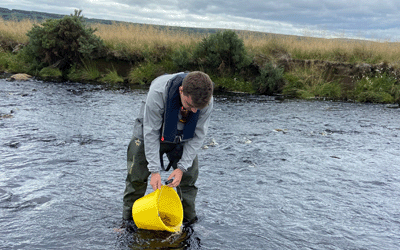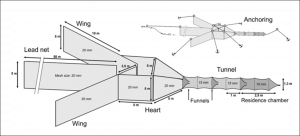Our wild salmon and sea trout are a vital part of Scotland’s heritage and they are now under threat. Fisheries Management Scotland are working alongside our members to support progress towards a formal regulatory system to manage interactions between wild and farmed fish. We are able to make the case for change through the vital monitoring work undertaken by our members.
Fisheries Management Scotland work alongside our members to monitor wild fish and develop a consistent approach to understanding the impacts of pressures Scotland’s wild fish face. One such pressure is salmon farming, where interactions between farmed and wild fish are highly complex, difficult to quantify and vary substantially between different areas. It is our view that an adaptive management approach – where the results of robust monitoring of impacts on wild fish inform farm management action – is the most appropriate route forward and should be incorporated into the new regulatory system. Our focus in this area is primarily on sea lice and escapes, but we are also exploring options to develop a better understanding of disease transfer.
Sea Lice Monitoring
Sweep Netting
Fishery Trusts in the ‘aquaculture zone’ (along the West Coast of Scotland) have undertaken a strategic programme of sweep netting to monitor juvenile sea trout and record the infestation pressure of sea lice for many years. This work is funded by Marine Scotland, and we are grateful for their continuing support. The reports and data arising from this work can be viewed here.
Coastal Fyke Nets
Alongside the established programme of sweep netting, we have also worked with Crown Estate Scotland and Marine Scotland to develop and refine wild fish monitoring techniques, and are working on a project to compare sweep netting with the deployment of a fixed bag net system (known as a coastal fyke net), previously trialled in Ireland and Norway. Using sweep nets is an established technique, but is mainly restricted to sampling sea trout and cannot be used on steep rocky shores, or over seabed with significant seaweed or boulders.
Coastal fyke nets have the potential advantage of capturing a more representative sample of the local population of fish, including juvenile salmon. The net design is similar to that of a commercial fixed engine salmon net (see Figure 1). A ‘leader’ net extends perpendicular from the shore and diverts fish into a v-shaped system of nets. Wild fish swim freely until the net is checked and fish are removed from the net to be released, following sampling for sea lice by researchers.
Lochaber Fisheries Trust developed the net design with help from wild fish researchers in Ireland and Norway. Mowi played an invaluable role through helping the Trust to deploy the net and supporting the day-to-day monitoring of fish through provision of boat and staff time. This collaborative approach has been extremely positive and successful in bringing the local wild fish and aquaculture sectors together to develop a better understanding of each other’s work. The opportunity for discussion and learning between the two sectors has led to improved understanding on both sides about the challenges our wild fish face and potential solutions.
The first phase of the project delivered a report on the preliminary results and a Standard Operating Procedure for the preparation and deployment of a fixed coastal fyke net for use by wild fisheries managers and other finfish farming companies. This will help form the basis of wild fish monitoring to be included in Environmental Management Plans and as part of the future regulatory regime.
The next phase of this project is to roll out coastal fyke net sampling across the aquaculture zone. We are grateful to Crown Estate Scotland for funding this project.
Monitoring for genetic introgression
There is an obvious genetic differentiation between wild fish and the fish that are farmed in aquaculture. When farmed fish escape into the marine environment, they can compete with wild fish for resources, and interbreed with the wild fish populations. The resulting offspring of interbreeding can be maladapted to their environment and do not survive as well as their wild fish counterparts. This can have a knock-on effect on the population’s continued viability.
Using genetic analysis, Atlantic salmon can be classified individually or by population, allowing the classification of genetically differentiated wild and farmed salmon. These differences can be used to confirm whether an individual is of farmed origin, or to assess the potential degree of interbreeding between farmed fish escapes and wild fish. Marine Scotland have published a report assessing the genetic integrity of wild fish populations across Scotland, which can be read here.
Prior to Fisheries Management Scotland, Rivers and Fisheries Trusts of Scotland (RAFTS) coordinated work to understand the extent of genetic introgression in Scotland in 2011. Juvenile salmon were sampled to gain a baseline understanding of the genetic diversity present across the West Coast. Across all sites, 369 out of 1472 individuals (25.1%) were identified as hybrids, which is significantly higher than that seen for the east coast ‘wild’ baseline. This work was funded by the Scottish Government, and the full final report can be accessed here.
Juvenile fish sampled from rotary screw traps operating on tributaries of Loch Shin in Scotland had characteristics suggesting they were of farm origin (scale losses, fin damage, and vaccination marks). No escapes had been reported to Marine Scotland and neither farm operator on the loch took responsibility for the escapees. To investigate their origins, baseline samples (n = 1200) were collected from the two freshwater smolt rearing facilities on the Loch and analysed by Marine Scotland. The results demonstrated that both operators were responsible for the escapes, and the full published report can be viewed in the ICES Journal of Marine Science.
As a result of this work, Fisheries Management Scotland are working with Marine Scotland to develop a programme of strategic sampling for open-cage freshwater salmon production sites across Scotland.
Following the escape of nearly 50,000 farmed salmon from Mowi Scotland’s North Carradale salmon farm, we have coordinated work to monitor for any genetic introgression arising from the escape. Working with Marine Scotland Science, a genetic monitoring project was designed which will allow us to measure any impact on the genetic integrity of local wild salmon population. Samples of juvenile fish have been collected by Fisheries Trusts across more than 100 sites, and genetic analysis is now being undertaken by Marine Scotland Science.
National Electrofishing Programme for Scotland (NEPS)
Annual electrofishing data is used to carry out an assessment of the status of Scotland’s salmon stocks each year. The first national survey was carried out in 2018 and this was repeated in 2019. The survey is designed, managed and analysed by Marine Scotland Science. Data is collected by local fisheries managers according to protocols developed by Marine Scotland Science.
out an assessment of the status of Scotland’s salmon stocks each year. The first national survey was carried out in 2018 and this was repeated in 2019. The survey is designed, managed and analysed by Marine Scotland Science. Data is collected by local fisheries managers according to protocols developed by Marine Scotland Science.
As part of the NEPS programme, genetic samples were also obtained from up to 30 parr at each of the multi-pass electrofishing sites to assess genetic introgression. This data is analysed by Marine Scotland Science and the reports for 2018 and 2019 are published.
Environmental Management Plans
Formal requirements for monitoring sea lice infestation pressure on wild fish are increasingly being included as a planning condition through Environmental Management Plans (EMPs). In 2019, the Scottish Government announced that an EMP is expected to be delivered as a condition of any consent for marine aquaculture planning applications. Consequently, local planning authorities are requiring an EMP for all new marine farm planning requests.
Marine Scotland requires that at a minimum an EMP must:
- be able to report on the level of lice released into the environment (i.e. both farmed fish numbers and adult female lice numbers);
- identify the likely area(s) of sea lice dispersal from the farm;
- detail how and what monitoring data will be collected to assess potential interaction with wild fish;
- detail how this monitoring information will feed back to management practice.
- include a regular review process to ensure that it remains fit for purpose.
An EMP is designed to inform an ongoing process of adaptive management to support farm management and inform future fish farm applications. Through an EMP, local authorities can better monitor sea lice control and any farm escapes during the lifetime of the planning consent. Additionally, District Salmon Fishery Boards and Fisheries Trusts can take a proactive role in providing feedback to farm management where impacts on wild fish are detected through monitoring.
Environmental Management Plans are an interim measure of governance ahead of the development of a reformed regulatory system. Whilst we accept that EMPs represent an imperfect solution, Fisheries Management Scotland are engaging with this process and support progress towards more formal regulation.



